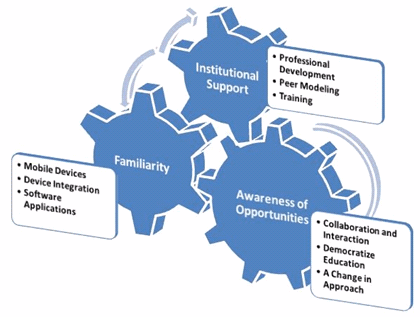Each issue of JOLT includes a section titled “Concept Papers” and this selection concerning m-Learning appears in the most recent edition’s concept paper section. In a one word summary, “Wow.” This article notes the explosion in online course offerings in the past decade, using a medium sized public institution (9,000 students, 500 faculty) as an example (between 2002 and 2008 online course offerings increased from 35 to nearly 3,000) and considers the prospect of “place independent” learning made possible via mobile devices such as iPods, PDAs and similar ICT (information and communication technology) devices.
Though I’ve spent some time today in Second Life, we live in a real world (sometimes anyway!). Though the authors undoubtedly wrote this article before the announcement of the iPad, I think it’s important to mention this new ICT in the context of m-Learning. Already one university has announced “an iPad for every student” under the tag line, “Think outside the classroom.” And that phrase very well summarizes the article Switching Gears, namely that ICT tools hold the potential to carry instruction and learning outside the confines of (even) computer connectivity. Again, wow.
Back to the article that is nicely summarized in this graphic supplied by the authors:

En route to the conclusion that developing m-Learning requires significant institutional support and investment, both for faculty curriculum development and technology infrastructure the authors makes several interesting observations. They begin with the question whether “ubiquitous laptop computing” is a truly viable future option for educational investment. I thought about the exercise early in the semester, perhaps it was at our first class meeting, when we were asked to devise the “ideal” computer laboratory and it bore little resemblance to our actual laboratory. A room full of comfortable chairs and sofas and an iPad in every lap would come closer to what most of us described as ideal. Mobile devices, the authors note, are always connected, offer unique affordances and are carried by just about everyone.
Through interviews with three faculty who have attempted to use some forms of m-learning technologies (such as podcasts and digital audio) the authors observe that today’s “digital youth” are perhaps not so adept with technologies such as podcasts as other studies have suggested. Music videos perhaps, but podcasts not so much so. In actual practice, transferring podcasts to mobile devices proved time-consuming and cumbersome for students (there’s that problem of technology getting in the way again…) and eventually in one course the faculty member resorted to simply streaming video from university servers on networked computers.
The ultimate goal of the faculty members interviewed for this article is to leverage the affordances of mobile devices to facilitate two-way, or one-to-many and ultimately many-to-many, communications but in the opinion of one faculty interviewee m-learning currently constitutes a one-way mechanism. The same faculty member finds the solution to that issue in more robust media and multimedia including (perhaps) the incorporation of social media (Facebook is cited as an example, though wikis may be another option).
Ultimately moving from e-Learning to m-Learning will require significant investments of time and effort on the part of the faculty, to recreate the curriculum for ICT devices, and significant institutional investments in technology infrastructure and support in the form of technology staff. At the end of these investments, though, lay the democratization of instruction on a scale that perhaps even the one laptop per child visionaries could not imagine.
Wow.
Source: Robert Crow, I.M. Santos, J. LeBaron, A.T. McFadden, C.F. Osborne, “Switching Gears: Moving from e-Learning to m-Learning,” MERLOT Journal of Online Learning and Teaching, Vol. 6, No. 1 (March 2010): 268-278.

I am going to put on my Luddite hat once again and rant against the explosion of technology in higher education, especially when it is not linked to a corresponding increase in pedagogical improvement.
First, college years used to be a time in which students learned who they were and who they were going to be. They learned to move beyond the assumptions and black and white world-views of childhood and adolescence and into a world of shades-of-gray where they were forced to challenge assumptions regularly. Removing students from the 7×24 interactions with others and judging success by their achievement of certain skills needed for career prep used to the realm of the technology institutes and career school, not four year universities.
Secondly, K-12 teachers must complete training in educational theories and practices before getting licensed. Faculty in higher education do not and assume that, because they learned successfully in a classroom dominated by the instructor, they should teach that way. The introduction of technology to higher ed classes requires a massive investment by the faculty in learning how to change their pedagogical approaches to ensure proper student outcomes. My experience so far has been that faculty want only to learn how to use the new technology and refuse to make any substantive changes to their teaching because they “know how to teach”.
I continue to look forward to that day when technology enhances educational outcomes without becoming a distraction that dilutes its original goals.
Hi Gil,
Check out the TechRhet listserv discussion on the iPad this month: http://www.interversity.org/lists/techrhet/archives.html
user id: techrhet
pw: blogeater
Yet another (and interesting comments re teaching with technology): http://www.insidehighered.com/news/2010/04/05/ipad
More on the iPad: http://www.insidehighered.com/blogs/technology_and_learning/why_cory_doctorow_is_wrong_about_the_ipad